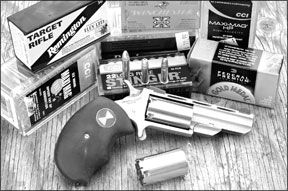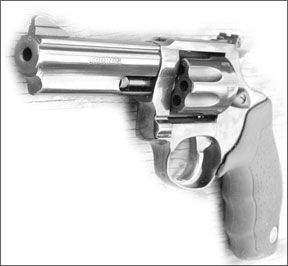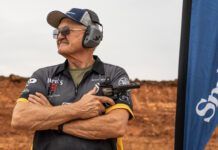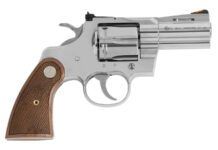Recently we took a look at .22 semiautos for the trail. In this report we look at an often neglected caliber, the .22 Magnum, in a trio of unusual revolvers. The versatility of the revolver lets you load it with a variety of loads, such as snake shot in one cylinder, high-velocity hollow-points in the next, and that can be a handy option on the trail. We chose to evaluate the .22 Magnum for this test, and found two small convertible revolvers from the same outfit, North American Arms, in their five-shot, spur-trigger single actions. One was the Black Widow, with 2-inch barrel and fixed sights ($287). The other was the 4-inch version, called the Mini Master, and though we looked hard for one with adjustable sights, we could not obtain one by our deadline. So we took a look at the Mini Master with fixed sights ($301). Both came with two cylinders, one in .22 LR and the other in .22 Magnum. Both are available with only one cylinder in either caliber for $29 less. We also chose a larger, heavier gun dedicated to the .22 Magnum, the 4-inch Taurus Model 941 ($373). It had adjustable sights.

An associate of Gun Tests declared his intention of arming himself against all and sundry predators with the Mini-Master. We told him we thought it was not the greatest idea. Our friend knew it was better to have some sort of gun than none at all, and he wondered how good the .22 Mag would be for self defense. We tested with three types of .22 Magnum ammunition in all three guns, and with three types of LR in the NAA guns. The magnum ammo choices, all 40-grain loads, were Remingtons PSP, CCIs Maxi-Mag HP, and CCI/Speer TNT HP. These cost from $10 to $12 for each 50-round box. The .22 LR ammo was Remington Target Rifle, Federal Gold Medal, and Winchester Super-X Power Points.
We though this small selection of revolvers would give us some idea of what to expect from the .22 Magnum and a few guns that handle it. We note some makers dont offer much in .22 Mag handguns anymore. Ruger and S&W used to produce a good variety, but today offer very little. Word is that Taurus will soon drop the .22 Mag from its revolver production. Could we be on to something? Heres what we found.
North American Arms
Black Widow
.22 Mag/.22 LR, $287
The grip on this pocketable gun was very comfortable. The workmanship, finish, and appearance were all excellent. The gun had visible sights and a decent trigger. Though we didnt like the idea of no trigger guard, we never missed it in practice. After all, the gun cant fire without the hammer being cocked, and you dont cock it until youre ready to shoot. We had no problems with the spur trigger. The next thing to strike us, after the good looks of the small gun, was its fine balance combined with its handy size. With an unloaded weight of 8.6 ounces, there would be few excuses for not being always armed if you owned this one. How well-armed you would be is another question entirely.
The guns operations were very simple. Put the hammer on the first notch, then pull downward on the lump under the barrel and twist it 90 degrees. This frees the cylinder pin so you can pull it forward off the gun, which frees the cylinder for removal. You now have three pieces, which right off we noticed isnt the best situation. Dont lose any of the three pieces, or you no longer have a gun. The cylinder pin is used to shuck empties from the cylinder. This worked well throughout our tests. One magnum round stuck once, so we struck the base of the pin with the rubber butt of the gun and solved that problem. You can safely load all five chambers. The cylinder is then held so the rounds dont fall out, and inserted into the frame. The base pin is then returned to its rightful position and the lump is turned to line up with the barrel. A little fiddling, if needed, gets the cylinder lined up and the pin fully seated. Then you can put the hammer carefully down into one of the notches between chambers, much like on the old 1851 Colt Navy, so you can carry the gun safely with all chambers loaded.
To fire it, cock it and press the trigger. We fired a few dozen shots from offhand, and noted the little gun was more accurate than we thought it would be. The rounds struck a bit high and to the left. Because both front and rear sights were mounted in dovetails it was relatively easy to get the windage corrected. Elevation proved to be more of a problem when we formally tested the gun from 15 yards. With the LR cylinder in place, most rounds struck about 3 inches high. But with the .22 Magnum cylinder in place, the rounds struck 7.5 to 8 inches high at 15 yards, and we could do nothing to correct this. The bottom line is, theres a big difference in impact between the Magnum loads and the Long Rifle loads with this gun. Would adjustable sights fix this? They might help, we thought, but they wouldnt solve all the problems.
The trigger pull was about 3.5 pounds, as well as we could measure it. Accuracy was excellent with .22 LR loads. Our best group of the test was five shots into 0.6 inches from our solid seated position at 15 yards, with Remington Target Rifle (by Eley) ammunition. Most five-shot groups with LR or Mag ammunition were about 2 to 2.5 inches. There was a lot more blast with the Magnum cylinder installed, and both LR and Mag (both NAA guns) gave significant blow-by and blast to adjacent fingers. Our fingers got quite black from this. With the Mag loads, the cylinder blow-by was painful if we got careless about finger placement. We had several failures to fire with Remingtons .22 Magnum load, in both of the NAA guns. The indents from the firing pins were, in all cases, plenty deep to have fired the round. We concluded it was a bad lot of ammo, not faulty guns.
Shortly into our testing, the hourglass logo on the right grip came loose. It would be simple to epoxy it back into place, but frankly, it causes us to doubt the integrity of an operation when simple things go wrong. But other than the bad ammo noted, we had no other problems with the little gun. We noted that one can get adept at reloading it, but it will never be a fast operation. We timed ourselves once at 30 seconds to recharge the gun, including removal of the cylinder, clearing the empties, reloading the chambers and replacing the cylinder into the gun. You can probably beat our time with practice, but its by no means a tactical gun, in our opinion. We could shoot the gun quickly, but unless we used the sights, we had poor results. We had little feel of this gun, so our “pointed” shots didnt hit even close to where we wanted them. Using the sights got us good hits, but the sight picture was far from perfect. The sights had excellent configuration. They had square tops, were large enough to be seen, and had no sharp edges, but the rear notch needed to be a lot wider. There was no light on the sides of the front blade.

Would we carry this gun on the trail? No. We thought it was too easy to drop one of the three parts of the gun into the lake while reloading, and reloading was not easy enough for a gun carried for fun, we thought. The accuracy was more than acceptable, but the gun didnt shoot anywhere near where it looked with Magnums, and not close enough with most LR ammo. However, we took a brief and informal look at Stingers and got hits very close for elevation, with what appeared to be excellent accuracy.
NAA Mini-Master
.22 Mag/.22 LR, $301
Our shooters were unanimous in their opinion of this revolver right from the start. They all thought it was a clumsy, ill-balanced, generally useless handgun. Like the other NAA gun, it was very well made, and it had an excellent stainless finish. The lack of adjustable sights (they add $29) was unfortunate, but it remained to be seen how much they would be needed. It was essentially impossible to put this gun into the pocket with any degree of comfort or security. That means it needs a holster, which tends to negate any advantage of its small size. If you must have a holster, why not fill it with a gun that holds more ammo and is easier to operate?
In practice, the sights of the long-barrel gun were essentially the same as on the short one, with not enough light around the front blade. The operations were all the same as the shorter gun. The blow-by and attendant painful fingers were the same. Gone was the Black Widow logo. The grips on both the guns were identical but for that logo, and we found them to be comfortable and useful. They gave decent control to the gun without adding much to its bulk. With both guns, it was easy enough to cock the gun with one hand, but easier to use the weak-hand thumb to do the work, especially for fast shooting. As with the smaller version, the lockwork felt precise, and cylinder lockup was very good.
Taurus Model 941
.22 Magnum, $373
The Taurus website (www.taurususa.com) still lists a 4-inch version of the Model 941, but doesnt show a picture. The website lists stainless and blued versions of these all-steel guns. All of em have a heavy lug under the barrel, upping the short ones weight to 24 ounces.
Our 4-inch gun weighed 28.6 ounces, so we suspect the listed weight of the 5-inch model will be higher than Taurus claims. We have been told all of these .22 Magnums will most likely not be offered by Taurus much longer. We looked forward to seeing how much more performance our 4-inch Taurus would give than the 4-inch NAA. After handling the NAAs, the Taurus seemed to be a huge, heavy gun. Thats perhaps one reason to pick the NAA for the trail over this one.
The Taurus had excellent bluing and workmanship, as is common to Taurus handguns. The firm rubber grips were exceptionally comfortable, with useful finger grooves and a pebbly surface to aid grip. The cylinder latch required a lot of force to open. The ejector rod throw lacked nearly half an inch of clearing empties from the cylinder. Lockup was very tight, with no cylinder play. The gun had adjustable sights with an excellent sight picture. The front blade was ramped, and serrated to cut glare. While we didnt approve of the heavy barrel lug, it gave the gun a muzzle-heavy balance that promised good results on target. We noted the hammer required a very strong effort to cock, and the double-action pull was so strong as to be essentially useless. It was well over 16 pounds, and made accurate double-action shooting impossible.
Despite that, we eagerly took the Taurus to the range, loaded up with the requisite Magnum (only!) loads, lined up the sights on target, and gently squeezed the clean, crisp, but slightly heavy 5-pound trigger. The hammer fell, and… nothing happened. We did it again and again, and when all that effort resulted in no noise whatsoever, we went looking. The hammer appeared to be improperly made. It would not depress the firing pin far enough to light off the rounds. There was only a slight mark on the rear of the cartridges, not enough to fire them. The hammer had a step that struck the frame before it struck the transfer bar to send the firing pin flying forward. The firing pin was a rebounding design, but it wasnt being driven hard enough to fire the gun. We managed to fire three rounds by repeatedly (6 to 8 times) dropping the hammer on a round. Two of those rounds went over the Oehler 35P chronograph to give us in excess of 1300 fps, which told us what to expect from a tightly fitted revolver firing .22 Magnum ammunition. This gave the lie to the 4-inch NAA with its looser fit, but left us wanting to know how well this otherwise finely fitted Taurus might have performed.
Still, without firing any groups whatsoever, we came up with some conclusions about the use of the .22 Magnum in the field, and of this Taurus in particular. Of course the no-firing situation will be instantly fixed by Taurus at no cost. We would then expect it to shoot reasonably well, like most Taurus revolvers, so the non-firing is not really a huge problem. But the Taurus was way too heavy for our purposes. Wed never pack this heavy a gun on the trail with this low power level. The 2-inch version is apparently not much lighter, 24 ounces and the same price. Sadly, the only 4-inch .22 LR revolver available, the Model 94B4, is all-steel with a heavy lug and 25 ounces dead weight.
Conclusions
In our quest for a reasonable .22 revolver for the trail, we fondly recall the old six-shot, 4-inch S&W Kitgun, all steel, and a delight. The current light S&W has Day-Glo green sights that are for us an abomination, and you cant buy the good sights and retro-fit em. Well give the heavy 4-inch Taurus .22 LR a chance in an upcoming test report, but were still looking to find an ideal revolver for the trail. For now, were stuck with a few good, light semiautos, and other than the delightful but too-short-barrel Taurus Ultra-Lite Nine, exactly no good revolvers for the trail whatsoever.
In case you havent got our drift about the .22 Magnum round, most of us here in Idaho consider it to be completely useless, although were told local gun shops sell quite a few guns for the trail (mostly 941s), and enough ammo to keep em running. Snake loads are popular. Concerning the use of the .22 Magnum for self defense, particularly in the five-shot NAA, we caution you that thugs seldom come alone. If you have but five shots and no chance for a fast reload, can you stop each of them with one round from the .22 Magnum? None of our shooters would take that bet.
We also noted a huge blast of fire out the front from the Mag loads. Thats not what youd want from a self-defense handgun. You dont want to blind yourself with your own muzzle flash. For the record, you dont need a .22 for anti-snake action. Weve fired many of CCIs .45 ACP snake loads in several 1911s, and could happily withstand an assault by a herd of black mambas.
Regarding the use of the .22 Magnum in the field, our old-timers have long felt that if a job cant be done with the .22 LR, go to the .38 Special and skip all the stuff in between. The old .32-20 would blow your ears off when fired from revolvers, and the same is true of the .32 H&R unless handloaded. But the .38 can throw fairly heavy bullets that will do something once they land, and wont bust your eardrums while so doing. Finally, we hesitate to inform our readers that the NAA is also available in .17 HMR, .17 Mach 2, and even in black powder versions, for those who want something entirely different, in the Monty Python sense.
POCKETABLE_22MAGS_ACCURACY0707.pdf






























